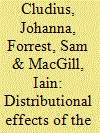|
|
|
Sort Order |
|
|
|
Items / Page
|
|
|
|
|
|
|
| Srl | Item |
| 1 |
ID:
125399


|
|
|
|
|
| Publication |
2013.
|
| Summary/Abstract |
Growing climate change and energy security concerns are driving major wind energy deployment in electricity industries around the world. Despite its many advantages, growing penetrations of this highly variable and somewhat unpredictable energy source pose new challenges for electricity industry operation. One issue receiving growing attention is the so-called 'merit order effect' of wind generation in wholesale electricity markets. Wind has very low operating costs and therefore tends to displace higher cost conventional generation from market dispatch, reducing both wholesale prices and conventional plant outputs. This paper extends the current literature on this effect through an empirical study employing a range of econometric techniques to quantify the impacts of growing wind penetrations in the Australian National Electricity Market (NEM). The results suggest that wind is having a marked impact on spot market prices and, while wind is primarily offsetting higher operating cost gas generation, it is now also significantly reducing dispatch of emissions intensive brown coal generation. Great care needs to be taken in extrapolating these results to longer-term implications, however, the study does propose a methodology for assessing this effect, highlights the impacts that wind is already having on NEM outcomes and suggests promising directions for future research.
|
|
|
|
|
|
|
|
|
|
|
|
|
|
|
|
| 2 |
ID:
177324


|
|
|
|
|
| Summary/Abstract |
Understanding competition in electricity markets is fundamental to developing good regulatory, market design and associated policy frameworks for the electricity sector. Where and when competition is effective, appropriate market designs can be largely left to run; where it is not, interventions may be needed. Despite the need to monitor competition in electricity markets, there appears to be a gap in the current literature around the competitiveness of the Australian National Electricity Market (NEM). This means that policymakers and researchers may not have enough information to adequately address the policy needs of Australia's electricity sector.
|
|
|
|
|
|
|
|
|
|
|
|
|
|
|
|
| 3 |
ID:
132621


|
|
|
|
|
| Publication |
2014.
|
| Summary/Abstract |
The Australian Renewable Energy Target (RET) has spurred significant investment in renewable electricity generation, notably wind power, over the past decade. This paper considers distributional implications of the RET for different energy users. Using time-series regression, we show that the increasing amount of wind energy has placed considerable downward pressure on wholesale electricity prices through the so-called merit order effect. On the other hand, RET costs are passed on to consumers in the form of retail electricity price premiums. Our findings highlight likely significant redistributive transfers between different energy user classes under current RET arrangements. In particular, some energy-intensive industries are benefiting from lower wholesale electricity prices whilst being largely exempted from contributing to the costs of the scheme. By contrast, many households are paying significant RET pass through costs whilst not necessarily benefiting from lower wholesale prices. A more equitable distribution of RET costs and benefits could be achieved by reviewing the scope and extent of industry exemptions and ensuring that methodologies to estimate wholesale price components in regulated electricity tariffs reflect more closely actual market conditions. More generally, these findings support the growing international appreciation that policy makers need to integrate distributional assessments into policy design and implementation.
|
|
|
|
|
|
|
|
|
|
|
|
|
|
|
|
| 4 |
ID:
096617


|
|
|
|
|
| Publication |
2010.
|
| Summary/Abstract |
Australia has been an early and enthusiastic adopter of both electricity industry restructuring and market-based environmental regulation. The Australian National Electricity Market (NEM) was established in 1999 and Australia also implemented one of the world's first renewable energy target schemes in 2001. With significant recent growth in wind generation, Australia provides an interesting case for assessing different approaches to facilitating wind integration into the electricity industry. Wind project developers in Australia must assess both potential energy market and Tradeable Green Certificate income streams when making investments. Wind-farm energy income depends on the match of its uncertain time varying output with the regional half hourly market price; a price that exhibits daily, weekly and seasonal patterns and considerable uncertainty. Such price signals assist in driving investments that maximize project value to the electricity industry as a whole, including integration costs and benefits for other participants. Recent NEM rule changes will formally integrate wind generation in the market's scheduling processes while a centralized wind forecasting system has also been introduced. This paper outlines experience to date with wind integration in the NEM, describes the evolution of market rules in response and assesses their possible implications for facilitating high future wind penetrations.
|
|
|
|
|
|
|
|
|
|
|
|
|
|
|
|
| 5 |
ID:
097460


|
|
|
|
|
| Publication |
2010.
|
| Summary/Abstract |
Australia has been an early and enthusiastic adopter of both electricity industry restructuring and market-based environmental regulation. The Australian National Electricity Market (NEM) was established in 1999 and Australia also implemented one of the world's first renewable energy target schemes in 2001. With significant recent growth in wind generation, Australia provides an interesting case for assessing different approaches to facilitating wind integration into the electricity industry. Wind project developers in Australia must assess both potential energy market and Tradeable Green Certificate income streams when making investments. Wind-farm energy income depends on the match of its uncertain time varying output with the regional half hourly market price; a price that exhibits daily, weekly and seasonal patterns and considerable uncertainty. Such price signals assist in driving investments that maximize project value to the electricity industry as a whole, including integration costs and benefits for other participants. Recent NEM rule changes will formally integrate wind generation in the market's scheduling processes while a centralized wind forecasting system has also been introduced. This paper outlines experience to date with wind integration in the NEM, describes the evolution of market rules in response and assesses their possible implications for facilitating high future wind penetrations.
|
|
|
|
|
|
|
|
|
|
|
|
|
|
|
|
| 6 |
ID:
115153


|
|
|
|
|
| Publication |
2012.
|
| Summary/Abstract |
The global climate policy environment is currently characterised by a small number of national or regional 'flagship' emissions trading schemes and a very large number of smaller more targeted 'flotilla' policies. We use an assessment framework to identify the characteristics of policies that affect their likelihood of introduction and alteration during the policy development process. We conclude that this mix of flagship and flotilla policies is at least in part an inevitable consequence of incumbent stakeholder pressure that results in flagship policies being blocked or weakened by those opposing action, and if weakened sufficiently, possibly blocked by those seeking stronger action. In contrast, smaller flotilla policies can be designed to have less impact on large incumbents and/or be of benefit to a different group of stakeholders who then provide political support. As a result, flotilla policies are likely to remain as key elements of the climate policy mix, to reduce emissions beyond those achieved by flagship policies, and to reduce emissions where no flagship policies exist. These findings have two consequences for policy design: the need to ensure that flagship policies do not reduce the effectiveness of flotilla policies, and that flagship policies are capable of being enhanced over time.
|
|
|
|
|
|
|
|
|
|
|
|
|
|
|
|
| 7 |
ID:
105794


|
|
|
|
|
| Publication |
2011.
|
| Summary/Abstract |
We briefly consider the tensions between climate change and energy security policy imperatives, and highlight some concepts that may bring additional clarity to decision-making at the nexus of the two areas. We focus on developing countries and use the case of the Medupi supercritical coal plant in South Africa. The justification for the plant's construction stemmed from an Integrated Resource Planning process informed by South Africa's national utility. Often, as in the case of South Africa, there are tensions not easily captured in quantitative algorithms between, inter alia, a lack of access to electricity by millions of people (and associated welfare losses) and greenhouse gas emissions from electricity generation. It is difficult to identify any formal processes that have prioritised climate change considerations over those of energy access. Thus, it becomes imperative to have a clear understanding of the consequences of this reality when considering power system expansion. We find that the processes often employed do not provide an entirely satisfactory precedent for future planning analyses, and the justifications do not adequately reflect the complexity of the decision space. Finally, we highlight some options by which these tools might be enhanced in areas including explicit and formal consideration of risk.
|
|
|
|
|
|
|
|
|
|
|
|
|
|
|
|
| 8 |
ID:
125415


|
|
|
|
|
| Publication |
2013.
|
| Summary/Abstract |
Least cost options are presented for supplying the Australian National Electricity Market (NEM) with 100% renewable electricity using wind, photovoltaics, concentrating solar thermal (CST) with storage, hydroelectricity and biofuelled gas turbines. We use a genetic algorithm and an existing simulation tool to identify the lowest cost (investment and operating) scenarios of renewable technologies and locations for NEM regional hourly demand and observed weather in 2010 using projected technology costs for 2030. These scenarios maintain the NEM reliability standard, limit hydroelectricity generation to available rainfall, and limit bioenergy consumption. The lowest cost scenarios are dominated by wind power, with smaller contributions from photovoltaics and dispatchable generation: CST, hydro and gas turbines. The annual cost of a simplified transmission network to balance supply and demand across NEM regions is a small proportion of the annual cost of the generating system. Annual costs are compared with a scenario where fossil fuelled power stations in the NEM today are replaced with modern fossil substitutes at projected 2030 costs, and a carbon price is paid on all emissions. At moderate carbon prices, which appear required to address climate change, 100% renewable electricity would be cheaper on an annual basis than the replacement scenario.
|
|
|
|
|
|
|
|
|
|
|
|
|
|
|
|
| 9 |
ID:
109665


|
|
|
|
|
| Publication |
2011.
|
| Summary/Abstract |
Distributed generation is being deployed at increasing levels of penetration on electricity grids worldwide. It can have positive impacts on the network, but also negative impacts if integration is not properly managed. This is especially true of photovoltaics, in part because it's output fluctuates significantly and in part because it is being rapidly deployed in many countries. Potential positive impacts on grid operation can include reduced network flows and hence reduced losses and voltage drops. Potential negative impacts at high penetrations include voltage fluctuations, voltage rise and reverse power flow, power fluctuations, power factor changes, frequency regulation and harmonics, unintentional islanding, fault currents and grounding issues. This paper firstly reviews each of these impacts in detail, along with the current technical approaches available to address them. The second section of this paper discusses key non-technical factors, such as appropriate policies and institutional frameworks, which are essential to effectively coordinate the development and deployment of the different technical solutions most appropriate for particular jurisdictions. These frameworks will be different for different jurisdictions, and so no single approach will be appropriate worldwide.
|
|
|
|
|
|
|
|
|
|
|
|
|
|
|
|
| 10 |
ID:
113472


|
|
|
|
|
| Publication |
2012.
|
| Summary/Abstract |
As a part of a program to explore technological options for the transition to a renewable energy future, we present simulations for 100% renewable energy systems to meet actual hourly electricity demand in the five states and one territory spanned by the Australian National Electricity Market (NEM) in 2010. The system is based on commercially available technologies: concentrating solar thermal (CST) power with thermal storage, wind, photovoltaic (PV), existing hydro and biofuelled gas turbines. Hourly solar and wind generation data are derived from satellite observations, weather stations, and actual wind farm outputs. Together CST and PV contribute about half of total annual electrical energy supply.
A range of 100% renewable energy systems for the NEM are found to be technically feasible and meet the NEM reliability standard. The principal challenge is meeting peak demand on winter evenings following overcast days when CST storage is partially charged and sometimes wind speeds are low. The model handles these circumstances by combinations of an increased number of gas turbines and reductions in winter peak demand. There is no need for conventional base-load power plants. The important parameter is the reliability of the whole supply-demand system, not the reliability of particular types of power plants.
|
|
|
|
|
|
|
|
|
|
|
|
|
|
|
|
| 11 |
ID:
068408


|
|
|
|
|
|
|
|